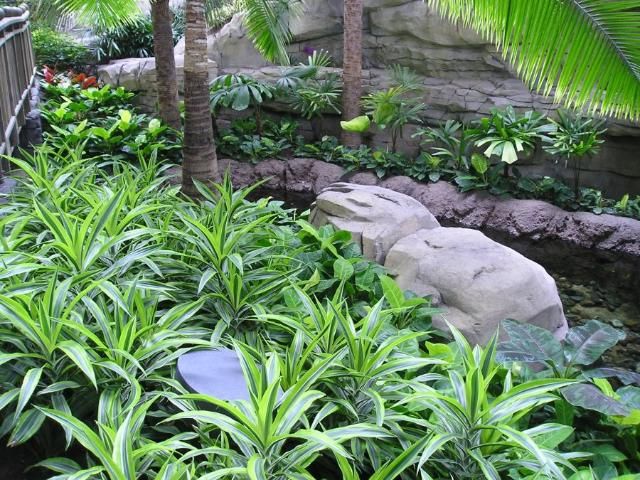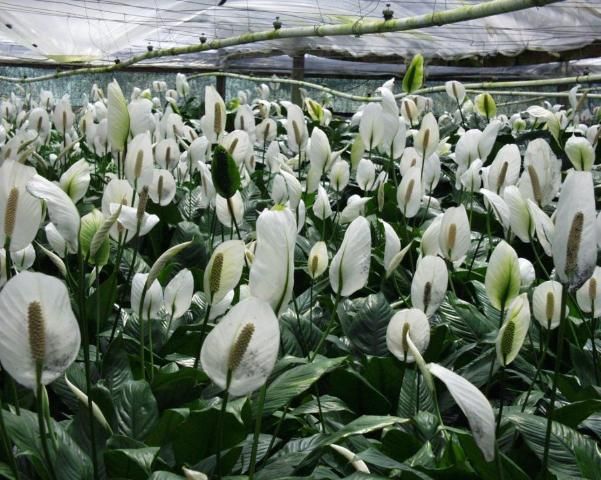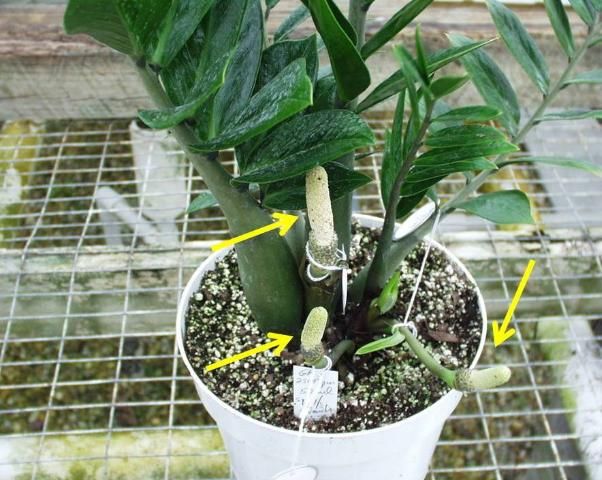Ornamental foliage plants are evergreen, herbaceous plants prized for colorful and attractive leaves rather than for flowers or fruits. Tropical foliage plants can be used for interior decoration in homes and offices, in large atriums, or as landscape plants in warmer climates (Figure 1). Currently, more than 500 species with various forms, colors, textures, and styles are grown as foliage plants.

Florida leads the nation in foliage plant production, accounting for more than 55% of the national wholesale market (Chen, Henny, and McConnell 2002). The foliage plant market is kept fresh and profitable by finding new plants from the wild, selecting mutants, and introducing hybrids (Chen and Henny 2008). As a result of such innovations, the Florida foliage plant industry has prospered for more than 100 years.
Even though they are prized for their beautiful leaves, flowers are induced in tropical foliage plants 1) to obtain flowers for breeding and 2) to obtain additional flowers for marketing purposes. There are several factors to consider when developing protocols for inducing blooms in tropical foliage crops. Photoperiod, temperature, and moisture (wet/dry cycles) influence flower production in all plants, including tropical foliage plants. This EDIS publication is for Florida nurserymen, interiorscapers, landscapers and horticulture industry professionals seeking information about improving flowering cycles on tropical foliage plants.
Plant Characteristics
Photoperiod
Because of their tropical origins, flowering cannot be induced for crop production purposes on most foliage plants by altering day and night lengths. In tropical and subtropical regions, day and night length are roughly equal and do not vary significantly through seasonal changes as they do in temperate climates. Some genera may sporadically flower with change in day length, but it is not economically feasible to manipulate day length when producing commercial foliage crops.
Temperature
Similar to photoperiod, temperatures in the tropics and subtropics vary only within a narrow range; therefore, foliage plants generally lack a temperature-driven dormancy response. In some cases, foliage plants may flower in the spring following intentional exposure to dryer and cooler temperatures during the winter months.
Wet/Dry Cycles
While homeowners may be pleased with an occasional bloom on their houseplants, a commercial grower must ensure uniform flowering across an entire greenhouse crop on a schedule to meet production demands. Likewise, a breeder must be able to ensure that flowers open predictably on breeding stock to enable cross pollination.
Chemical Induction
For commercial and breeding purposes, two plant growth regulators are routinely applied to predictably induce flowering of foliage plants. These are gibberellic acid (GA3; Pro-Gibb T&O®) and ethephon (Florel®).
Gibberellic Acid
Gibberellins are naturally occurring plant hormones. Gibberellins were first identified and extracted from fungi in 1935 (Yabuta and Sumiki 1938). Gibberellic acid was subsequently refined and commercially produced by researchers in 1954 (Curtis and Cross 1954). Gibberellins cause cell enlargement and elongation.
In order to have flowers available for breeding at the University of Florida Mid-Florida Research and Education Center in Apopka, Henny (1980) treated and successfully flowered Dieffenbachia using gibberellic acid (GA3). Subsequently, many genera of foliage plants in the Araceae plant family (plus Cordyline; family Asparagaceae) were shown to bloom predictably in response to GA3 application (Table 1).
Aglaonema—The use of GA3 treatment is imperative for Aglaonema breeding to ensure simultaneous flowering of different species and cultivars. Natural flowering cycles of Aglaonema are highly variable and sporadic, which limits their ability to make cross pollinations. A single foliar spray with 250 ppm GA3 consistently induces flowering and increases flower number in many Aglaonema species. Time from treatment to blooming is about 4–5 months (Henny 1983). Aglaonema flowers have no ornamental market value and are removed if not used for hybridization.
Anthurium—Anthurium is prized as cut flowers and as flowering potted plants. Anthurium flowers often bloom under natural conditions without hormone inputs. Application of GA3 is reported to cause branching; therefore, more flowers can be produced, and the plant looks thicker and fuller in the pot. If Anthurium flowers are to be induced for breeding purposes, A. scherzerianum has shown a positive flowering response to GA3 treatments in research trials, but only at high light levels (Henny and Hamilton 1992).
Caladium—While Caladium cultivars are valued for their brilliant leaf colors and patterns, gardeners would not find their small, beige, semi-inconspicuous flowers desirable. Flowers are induced for breeding purposes only. Tubers removed from storage and soaked for 8 or 16 hours in 250 ppm GA3 produced flowers after approximately 65 days (Harbaugh and Wilfret 1979).
Cordyline—Also known as Ti plant or Hawaiian good-luck plant, Cordyline terminalis produces terminal inflorescences 4–6 weeks after apical buds are treated with GA3 or GA4+7 (Fisher 1980). Optimum flowering requires application of 0.12–0.15 ml of 500 ppm GA3 or GA4+7 applied to the apical bud. Some selections of Ti plant are used extensively as cut florist greens. Flowers should be induced for breeding purposes only.
Dieffenbachia—The ability to flower Dieffenbachia species and cultivars simultaneously on demand has made breeding this popular plant much easier (Henny 1980). Flowering is accomplished by a single foliar spray with 250 ppm GA3. Flowers normally mature within 3–4 months following treatment. Tetraploid Dieffenbachia breeding lines have proven more difficult to flower using GA3 sprays and require higher treatment rates than diploid plants. Even at rates of 500 ppm, only 30%–80% of tetraploid Dieffenbachia flowered compared to 100% of diploids (Henny 1989).
Homalomena—Homalomena lindenii plants can be stimulated to flower with a single foliar spray to runoff with 100 ppm GA3. Treated plants flowered within approximately 120–140 days. All treated plants averaged 10–11 flowers, while untreated plants did not bloom (Henny 1988).
Philodendron 'Black Cardinal'—a self-heading type of Philodendron, flowered approximately 168 days or 6 months after a single foliar spray application of GA3 at 500 ppm. One hundred percent of treated plants subsequently flowered (Chen et al. 2003). Flowers should be induced for breeding purposes only. To date, no vining types of Philodendron have shown a positive bloom response to GA3 applications.
Spathiphyllum—When the ability to induce flowering of Spathiphyllum with GA3 was first reported (Henny 1981), it moved this crop from the category of foliage plant into the flowering potted plant category. Initially, Spathiphyllum 'Mauna Loa' seedlings flowered after receiving a single foliar spray of GA3 at 250, 500, or 1000 ppm. Most treated plants had visible buds or open blooms within 12–14 weeks of treatment. In that study, approximately 15% of the inflorescences exhibited bloom distortion consisting of either curved peduncles or spathes with extra appendages.
Subsequent testing on other cultivars was conducted since flower distortion was not desirable for marketing purposes. Four additional Spathiphyllum cultivars were given a single foliar spray with 250 ppm GA3 in August 1984. The cultivars tested included 'Tasson', 'Wallisii', 'Queen Amazonica', and 'Bennett' (Henny and Fooshee 1985). All four cultivars flowered readily in response to GA3 treatment. Treated 'Bennett' and 'Wallisii' plants had open blooms within 9 weeks of treatment. 'Tasson' and 'Queen Amazonica' required approximately 2 weeks longer to flower. Overall flower quality was good for 'Bennett' and moderate for 'Tasson' and 'Queen Amazonica'. 'Wallisii' produced poor-quality flowers.
Spathiphyllum 'Starlight' was treated with a single foliar spray of GA3 at 0, 125, 250, or 375 ppm in March 1988. All treated plants had good-quality flowers at 15 weeks after treatment while no untreated plants bloomed (Figure 2). GA3-treated plants were slightly taller and had new leaves that were narrower than untreated plants (Henny and Fooshee 1988). It was concluded that different cultivars of Spathiphyllum respond differently to GA3 treatments. Each cultivar must be tested on a small-scale basis before GA3 is applied to an entire crop.

Zantedeschia—GA3 can be applied to calla lily at 500 ppm as a 10-minute preplant rhizome soak. Soaking rhizomes in 500 ppm GA3 prior to planting increased the number of flowering shoots and flowers per shoot (Corr and Widmer 1987). Leaf width was narrower on treated plants, but length was not affected. GA3 may also be applied as a foliar spray. Foliar sprays were applied when the first leaf was unfolded on half of the plants. However, foliar sprays were generally not effective. Treatment of the tubers is essential for uniform sprouting and blooming of this crop, either for cut flower or flowering potted plant production.
Zamioculcus—ZZ plant is prized for its durability as a foliage plant in low light interior conditions. ZZ can be induced to bloom for breeding purposes (Figure 3). Application of 500 ppm GA3 as a foliar spray induced 90% of plants treated to bloom approximately 135 days after treatment (R. J. Henny, unpublished data).

Ethylene
Ethylene is a gas naturally produced by all plants. Ethylene is generally not desirable around florist crops because it causes flower abscision; however, in other crops, ethylene is used to ripen fruits and to induce blooms (Table 2). Ethephon, invented in 1965, is a liquid that converts into ethylene and acts as a plant hormone after it is sprayed on plants. Ethephon is used for a wide variety of agronomic crops, such as wheat, coffee, cotton, and rice, and is sold under a variety of product names.
Bromeliads—Studies with Aechmea, Guzmania, and Vriesea showed that 25 mg/L of ethephon applied to the vase of these bromeliads, 1.5–2 years old at the time of treatment, induced flowering (Figure 4) within 2 months without damaging leaves (Poole and Conover 1975). In the above study, the vases contained water from overhead watering the day before treatment, so it is not necessary to drain existing water from the vases before applying the ethephon.
Ficus—Application of 500 ppm ethephon to Ficus benjamina liners in 2-gallon pots stimulated flowering and seed set (Johnson and Joiner 1978). These results may be of value to breeders of ornamental Ficus; however, growers should note that root growth was severely reduced and top growth became prostrate.
Gynura—Ethylene does not induce flowering in purple passion plant, but it serves an important function in this foliage crop. The flowers of Gynura have a foul odor that is not appealing to consumers and detracts from market value. Flowers drop following a foliar spray of ethephon at 500 ppm (Chen, Henny, and Caldwell 2002).

Gibberellic Acid and Ethephon Sources
Gibberellic acid can be purchased as Pro-GibbT&O®. Read and follow all label directions. Other products may be registered with this active ingredient.
Ethephon for greenhouse and horticultural use can be purchased as Florel® (Henny 2001). Other products may be registered with this active ingredient. Read and follow all label directions.
Literature Cited
Chen, J., and R. J. Henny. 2008. Tropical Foliage Culitvar Development: New Ornamental Introductions Drive Plant Markets. ENH1093. Gainesville: University of Florida Institute of Food and Agricultural Sciences. https://edis.ifas.ufl.edu/ep357.
Chen, J., R. J. Henny, and R. D. Caldwell. 2002. "Ethephon Suppresses Flowering of Purple Passion (Gynura aurantiaca)." Journal of Environmental Horticulture 20 (4): 228–231.
Chen, J., R. J. Henny, and D. B. McConnell. 2002. "Development of New Foliage Plant Cultivars." In Trends in New Crops and New Uses, edited by J. Janick and A. Whipkey, 466–472. Alexandria, VA: ASHS Press.
Chen, J., R. J. Henny, D. B. McConnell, and R. D. Caldwell. 2003. "Gibberellic Acid Affects Growth and Flowering of Philodendron 'Black Cardinal'." Plant Growth Regulation 41: 1–6.
Corr, B. E., and R. E. Widmer. 1987. "Gibberellic Acid Increases Flower Number in Zantedeschia elliottiana and Z. rehmannii." HortScience 22 (4): 605–607.
Curtis, P. J., and B. E. Cross. 1954. "Gibberellic Acid: A New Metabolite from the Culture Filtrates of Gibberella fujikuroi." Chem. Ind. (London) 1066.
Fisher, J. B. 1980. "Gibberellin-Induced Flowering in Cordyline (Agavaceae)." Journal of Experimental Botany 31 (3): 731–735.
Harbaugh, B. K., and G. J. Wilfret. 1979. "Gibberellic Acid (GA3) Stimulates Flowering in Caladium hortulanum Birdsey." HortScience 14 (1): 72–73.
Henny, R. J. 1980. "Gibberellic Acid (GA3) Induces Flowering in Dieffenbachia maculata 'Perfection'." HortScience 15 (5): 613.
Henny, R. J. 1981. "Promotion of Flowering in Spathiphyllum 'Mauna Loa' with Gibberellic Acid." HortScience 16 (4): 554–555.
Henny, R. J. 1983. "Flowering of Aglaonema commutatum 'Treubii' Following Treatment with Gibberellic Acid." HortScience 18 (3): 374.
Henny, R. J. 1988. "Inducing Flowering of Homalomena lindenii (Rodigas) Ridley with Gibberellic Acid." HortScience 23 (4): 711–712.
Henny, R. J. 1989. "Floral Induction in 2n and 4n Dieffenbachia maculata 'Perfection' After Treatment with Gibberellic Acid." HortScience 24 (2): 307–308.
Henny, R. J. 2001. "Tips on Regulating Growth of Floricultural Crops." In Foliage Plants, edited by M. Gastson, 83–87. Columbus: Ohio Florists Association.
Henny, R. J., and W. C. Fooshee. 1985. "Inducing Flowering of Four Spathiphyllum cultivars with Gibberellic Acid (GA3)." CFREC-Apopka Research Report RH-85-3. Gainesville: University of Florida Institute of Food and Agricultural Sciences.
Henny, R. J., and W. C. Fooshee. 1988. "Floral Induction in Spathiphyllum 'Starlight' with Gibberellic Acid Treatment." CFREC-Apopka Research Report RH-88-17. Gainesville: University of Florida Institute of Food and Agricultural Sciences.
Henny, R. J., and R. L. Hamilton. 1992. "Flowering of Anthurium Following Treatment with Gibberellic Acid." HortScience 27 (12): 1328.
Johnson, C. R., and J. N. Joiner. 1978. "Influence of Ancymidol and Ethephon Growth of Ficus benjamina L." Proceedings of the Florida State Horticultural Society 91: 204–205.
Poole, R. T., and C. A. Conover. 1975. "Flowering of Bromeliads." Florida Foliage Grower 12 (6): 1–2.
Yabuta, T., and Y. Sumiki. 1938. "On the Crystal of Gibberellin, a Substance to Promote Plant Growth." Journal of the Agricultural Chemical Society Japan 14: 1526.